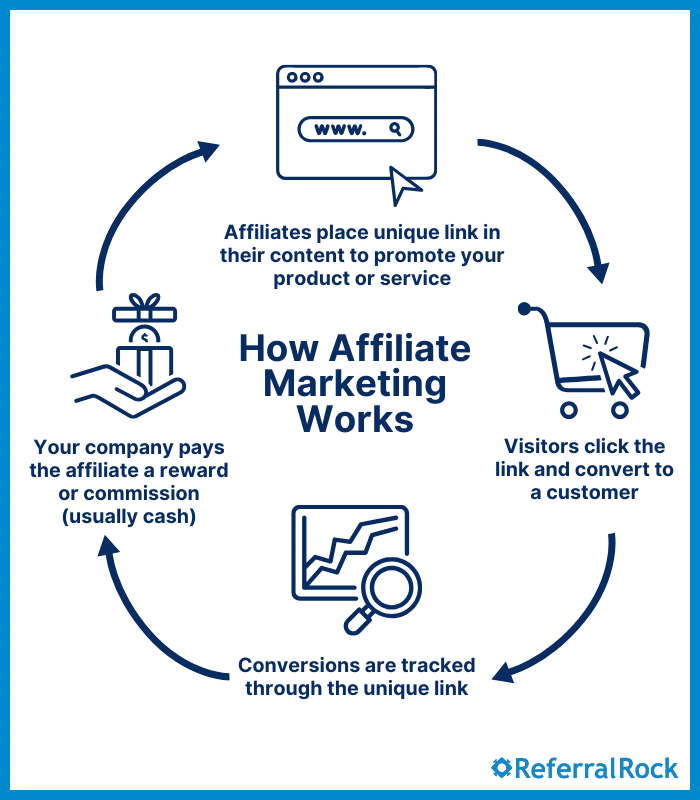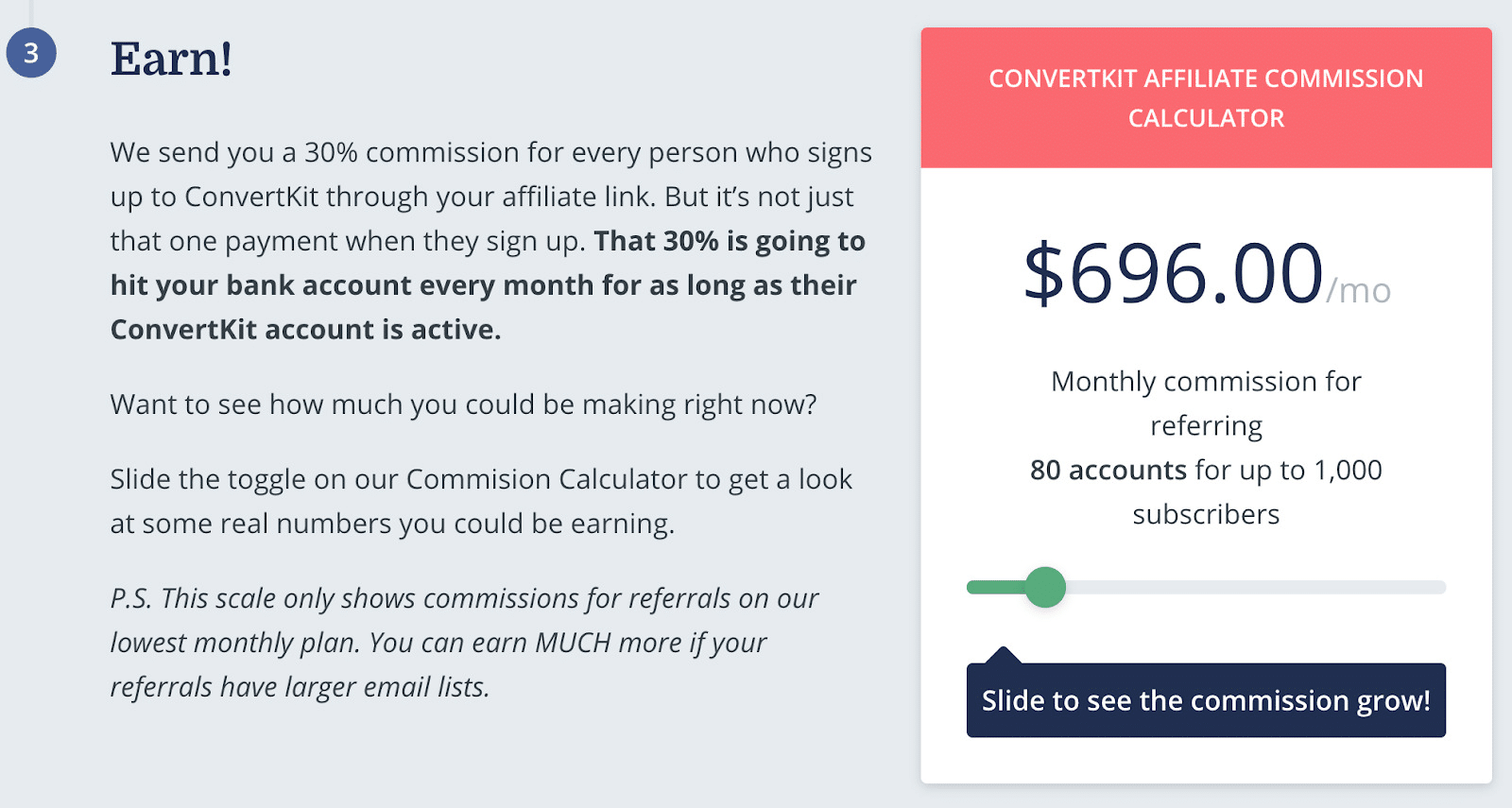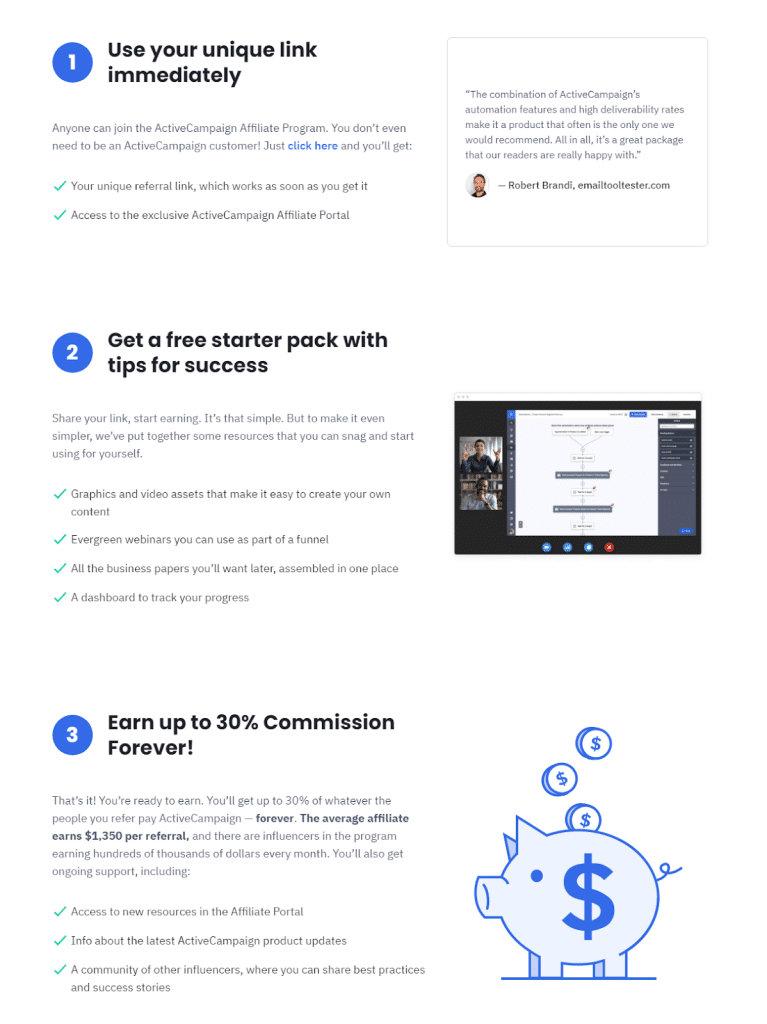Even though the concept may seeem simple enough, starting and running a successful B2B affiliate program requires many strategic decisions. You’ll need to find and train affiliates, as well as decide on a competitive and sustainable commission. You also need to track the ROI of your affiliates, and make sure they follow all the guidelines when promoting your product. And that’s all after making sure you’re a good fit in the first place.
How do you know if a B2B affiliate program is the right call for your business? And what are the best tips to start B2B affiliate marketing, recruit affiliates, and set commissions?
Let’s dive in.
What is a B2B affiliate program?
In a B2B affiliate marketing program, you recruit respected content creators (like influential industry bloggers, social media personalities, website owners and email marketing publishers) to promote your B2B company on their own channels.
The content creators, known as affiliates, place links to your website within their content.
Every time someone converts – becomes a qualified lead or makes a purchase – as a result of clicking on an affiliate’s link, you reward the responsible affiliate by paying them a commission.
By rewarding your affiliates with a commission for every sale, you encourage them to help propel your brand’s growth even further.
Do B2B affiliate programs work?
Does affiliate marketing work for B2B businesses?
The answer to this question is a resounding yes.
Affiliate marketing isn’t just for B2C ecommerce businesses – B2B affiliate marketing is extremely effective.
Build a B2B affiliate program (business to business affiliate program) the right way, and your B2B will have an effective channel for lead generation and sales.
After all, affiliates are usually trusted content creators in your industry. And when they promote your products or services on their sites, potential buyers listen and are more willing to see what you have to offer.
Why start a B2B affiliate marketing program?
Here are some of the top reasons why B2B marketers can benefit from affiliate programs:
1. Harness trusted voices: Affiliate marketing is a word-of-mouth powerhouse because consumers trust industry authorities and peers more than messages that come directly from a brand. Plus, these consumers will be more likely to share the message with their family and friends.
2. Measurable word of mouth: All B2B marketing efforts should be measurable and data-driven. Often, though, word of mouth can be difficult to track. But when you set up an affiliate program, you’ll be able to attribute a sale to the exact affiliate responsible, know how many sales resulted from a given affiliate link you’ve created, and track how much you’ve paid out in affiliate commissions. This makes it easy to measure your ROI
3. Highly targeted marketing: Affiliates can help you move prime leads through your sales funnel. Select affiliates who have already captured your target audience and are respected in your niche, and B2B decision-makers are bound to listen.
4. Cost-effective and low-risk: Since you only pay affiliates after they’ve successfully generated a qualified lead or a sale, affiliate marketing produces results with less risk for your business.
5. Increased leads and sales: Affiliate marketing is flexible – you can ask affiliates to point potential customers toward any page on your website. By having affiliates link to a targeted landing page optimized for your program, you can directly generate high-quality B2B leads. You can also vary the landing page designs, depending on the audience of each individual affiliate partner.
These statistics prove why you shouldn’t sleep on B2B affiliate marketing:
- 15% of digital marketing revenue can be attributed to affiliate marketing.
- In the U.S., affiliate marketing spend experiences a 10% growth each year.
- By 2027, the global market size for affiliate marketing is predicted to be almost $28 billion.
How to know if a B2B affiliate program is right for you
Even though affiliate marketing can be a powerful digital marketing strategy for your B2B, it should meet several standards to be successful and sustainable. Before starting an affiliate program, be sure that:
- You have high customer retention rates: Since you’ll be paying affiliates a portion of every sale they bring in, it’s more sustainable if these sales turn into long-term customer relationships and continued profits for your business.
- You have reasonably high margins: Affiliate programs work best for businesses with high profit margins, such as software companies and subscription-based businesses.
- You’ve clearly identified your prime target audience, and have an idea of the niche content creators they trust most. It may also help if you have an existing relationship with at least some of these content creators, so it’s easier to form an affiliate partnership.
- You can find other relevant affiliates to promote your business on their own marketing channels and drive traffic directly to your website.
- These affiliate marketers are able to reach people they don’t know personally, in an indirect manner, by promoting your product/service within their content.
- You’re willing to pay competitive affiliate commissions in cash, every time an affiliate helps you make a sale.
- You have an idea where and how your affiliate program will fit into your B2B sales cycle, including how long an affiliate is eligible to earn a commission after someone clicks on their affiliate link.
Our top 10 tips for starting a B2B affiliate program
Once you’ve decided an affiliate program is right for you, follow these tips to set it up for success. Below are the best B2B affiliate marketing strategies, based on our experience:
1. Know where affiliates will fit into the buyer’s journey
The main difference between B2C and B2B affiliate programs is the longer and more intensive B2B sales cycle.
Compared to B2C buyers, B2B decision-makers tend to do much more research on products or services before purchasing, usually consult with several stakeholders, and are seeking long-term deals that last at least a few years.
In addition, B2B buyers often require a highly personalized experience. They want to know exactly how your product or service will meet their needs, and receive hands-on assistance during every part of the sales funnel.
Where do B2B affiliates fit into this process? Since affiliates are trusted authorities in your niche, they’re instrumental in building trust among prospective buyers, and generating qualified leads and sales.
Depending on your affiliate marketing goals, you can design appropriate landing pages for affiliates to link to – pages with a direct sales offer, or a call to action encouraging email sign-ups. Personalize these pages based on the needs of your target audience, and encourage your affiliates to address these needs when they include your link.
2. Set strategic affiliate KPIs
All B2B marketing strategies must be measurable and data-driven. B2B affiliate programs are no exception.
Once you’ve decided to start an affiliate program, set measurable goals for leads and sales. This way, you’ll be able to tell if your program is successful.
Here are some KPIs you should focus on:
- Amount of revenue you’d like affiliates to bring in per quarter or per year
- Number of qualified leads you want your affiliates to attract per quarter or per year. (Keep in mind, it may take a while before a lead converts to a sale.)
- Conversion rate, or the percentage of people who ultimately purchase after clicking on an affiliate link
- Number of unique sales that result from affiliate links
3. Figure out where you’ll find B2B affiliates
To see the greatest success in your affiliate program, it’s important to have a rigorous selection process when finding affiliates. B2B businesses should use targeted affiliate outreach: it’s best to personally reach out to the affiliates you want, rather than posting an open application and having them come to you.
Affiliates don’t necessarily have to use your product or service regularly. But they should be trusted content creators and respected by other B2B buyers.
Look for reputable established B2B professionals and influencers your target customers already follow and trust, along with other niche creators, who produce quality content that aligns with your brand.
Then, make a list of people who meet these criteria – ones you’d like to be your affiliates. If they’re familiar with your product or service (or even already use it), even better.
Also consider choosing affiliates across different segments of your target market. This helps create an affiliate network that delivers personalized messages to their audience, and directs warm leads to specific, tailored landing pages.
4. Don’t overlook existing customers when choosing affiliates
The biggest B2B affiliate program mistake is to forget about inviting existing customers to become affiliates.
Sometimes, existing customers can also be an influential voice in the B2B space, with a considerable audience that could greatly benefit from your product.
The best part of having an existing customer join your affiliate program is they can authentically and directly share how your product helps them, and could potentially help other businesses. In fact, customer-affiliates may likely be your best advocates!
5. Set competitive affiliate commissions
Offering the right commission is key to your affiliate program’s success. Commissions should be paid out in cash, as either a fixed amount or percentage of a sale.
Run a competitive analysis to make sure your own affiliate commission will seem attractive. Compare the commission you plan to set against the programs of both direct competitors and other companies that might be recruiting the same affiliates. For instance, if most competitor affiliate programs have a 10% commission, offering a 5% commission won’t be effective.
But one-upping the competition’s affiliate programs isn’t always your best strategy.
To determine the best commission for your B2B, consider your customer acquisition costs, your retention rate, and your average customer lifetime value.
With these numbers in mind, decide on a commission rate your business can afford to pay out, while still being attractive to your potential affiliates.
6. Set commission rules carefully
In light of the longer B2B sales process, set commission rules that will still keep B2B affiliates motivated.
For B2Bs, multi-step commissions work well. This structure involves paying affiliates a small fixed commission for every qualified lead they bring in, and then a larger commission when one of their leads converts to a sale.
You can also reward a commission bonus to affiliates who bring in a specified number of qualified leads or sales within a time period (quarterly or annually).
Or, you can offer a permanent commission boost once an affiliate exceeds a given amount of lifetime sales, in what’s known as a tiered structure.
Here are other commission rules to consider:
- How long are affiliates eligible to earn a commission after someone clicks on their link?
- If an affiliate brings in a qualified lead, will they automatically earn a commission if that lead makes a purchase, no matter how long before the purchase is made? Or must the lead purchase within a set period?
- What happens to an affiliate’s commission if a product is returned or a service is cancelled? How does this align with your existing return/cancellation policy?
- If you’re a subscription-based business, will affiliates also earn a commission when a customer they brought in renews their subscription? For how long?
Once you determine your commission rules, set your affiliate tracking cookies to monitor all relevant steps in your sales funnel so you can automate payouts throughout your program.
ConvertKit’s affiliate program pays out recurring commissions. As long as a customer who signed up via an affiliate link stays active, the affiliate whose link they used keeps earning a commission on purchase renewals. Source
How to make your B2B affiliate program lowest-risk? Only pay a commission when your business knows it has received a return on investment (for a qualified lead or sale). You could also set lower commissions for newer affiliates and higher commissions for established affiliates, as mentioned above.
Automatically handle affiliate payouts with PayPal and Wise integrations, or set up the custom cash payouts of your choice.
Here’s more on how we can help your B2B automate commissions >
7. Form your own affiliate network
Going through an existing affiliate network may seem like it will save you time and effort.
But for any long-term affiliate marketing, it’s much more effective to cut out the middleman and form your own affiliate network. By recruiting your own affiliates, you can save money and have more control over your affiliate program.
Yes, an affiliate network will recruit and manage affiliates for you. But they also charge their own fees (sometimes as high as 30%) on top of the commission you pay affiliates directly.
If you form your own network:
- You won’t have to pay extra fees to an existing network.
- You’ll have direct access to all your affiliate data. This makes data tracking much easier and quicker. It also lets you implement rapid, data-driven adaptations and optimize your program’s performance.
- You’ll also be able to form more authentic relationships with your affiliates.
- Plus, you can optimize your affiliate network to appeal to all your audience segments. After all, you can choose any affiliates you want (not just affiliates bound to an existing network).
8. Choose the right affiliate software
Affiliate software is a must when forming your network of affiliates. It streamlines your program with automation and lets you instantly track key metrics. By using affiliate marketing software, you’ll always know which affiliates are responsible for which sales, automate your payouts, and strengthen your best affiliate relationships.
Affiliate software gives you full control over all aspects of your program, and typically includes a dashboard or portal, where affiliates can track their progress. It also streamlines all communication and support, and helps keep affiliates motivated.
Plus, affiliate management software usually costs much less per year than the fees paid to an existing affiliate network.
Why choose Referral Rock affiliate software?
Referral Rock affiliate software lets you take full control of your affiliate program, with all the tools, data, and support you need for success:
- Set up your program easily and launch quickly, thanks to prebuilt templates and expert guidance from an onboarding specialist
- Select any commission structure you want (we support tiered, recurring, and limited-time commissions)
- Customize your affiliate experience with our easy program builder
- Seamlessly integrate Referral Rock with your existing tools and processes, including your CRM (we play well with HubSpot, Salesforce, Shopify, and 50+ other tools)
- Keep affiliates engaged by giving them full visibility on their progress via a dedicated portal, and by sending monthly emails with updates on their progress
- Track affiliates’ sales through detailed metrics, so you always know your ROI
- Manage affiliates on your terms, and automate key processes, without being held back by a marketplace
Learn more about how Referral Rock can help you give your affiliates the best experience >
9. Educate affiliates on your B2B sales cycle
After recruiting your affiliates, train them on your brand and program fundamentals. Provide your brand guidelines, any terms and conditions they should know when promoting your product/service, and the requirements to earn a commission. Then, have them sign an agreement that includes all these points.
One often overlooked step, however, is educating affiliates on your B2B sales funnel or buyer’s journey.
- It’s important for B2B affiliates to know where they fit into your process, especially if they’re more familiar with B2C sales cycles.
- Emphasize the needs of your target customer, and the affiliate’s role in building trust and lasting relationships with prospective leads.
- Also, make sure they understand that the B2B sales process typically takes more time. But if all parts of the sales funnel work together, your affiliate’s work will pay off.
Don’t abandon affiliates after this initial training, either.
- Make a plan to regularly check in with affiliates at set times (this can be done through an affiliate dashboard or exclusive LinkedIn, Facebook or Slack group).
- Let them know how to contact you as well, in case they have any questions.
- Keep your affiliates up-to-date with brand assets and resources, such as descriptions and benefits of new products or marketing campaigns.
- You can even let them try out your product or service for free or at a discount, so they have firsthand experience with what your brand offers.
ActiveCampaign trains and educates affiliates in several ways: a starter pack; easy access to product updates; graphic, video, whitepaper, and webinar assets; and even an affiliate community where affiliates can learn from their peers.
Keep affiliates engaged with Referral Rock’s top-notch affiliate experience. Set up a branded portal where they can quickly track deal progress, give them ready-made sharing messages, and send update emails at strategic times to keep them in the loop.
10. Refine your program based on data
As with all marketing strategies, don’t just launch your B2B affiliate program and leave it be. Keep track of your affiliate program’s progress, and make any necessary adjustments based on feedback and findings.
Using data analytics from your affiliate software, check how well the program measures up to the KPIs you set during planning.
Look at:
- Total revenue
- Conversion rates
- Qualified leads generated
- Unique sales
- Which affiliates are bringing in the most leads and sales
If your B2B affiliate program isn’t meeting your goals, it may be time to adjust your commission structure or rework your affiliate lineup.
Wrapping things up
Now that you know the top B2B affiliate program tips, look for ways to apply them and set your affiliate program up for success.
To brush up on affiliate program fundamentals, take a look at these guides:
- Affiliate Marketing Best Practices
- Affiliate Marketing for SaaS Companies: Our Dedicated Guide
- Affiliate Marketing Vs. Partner Marketing
And if you’re looking for some examples on real-life programs, we put together 10+ affiliate marketing examples to inspire you.







